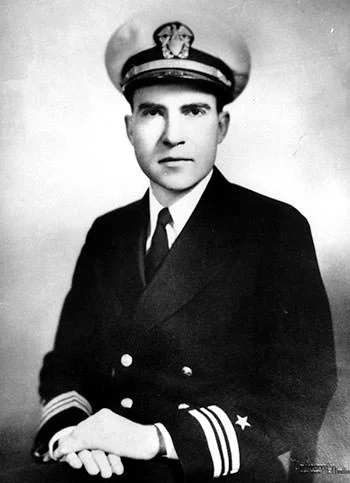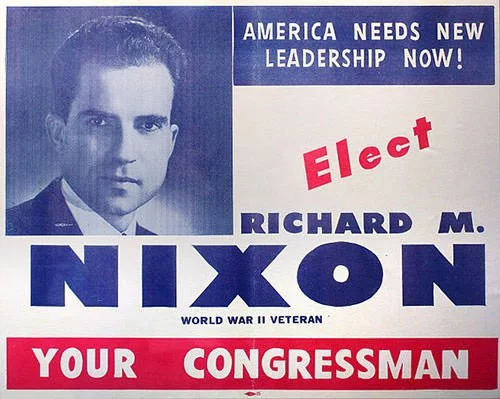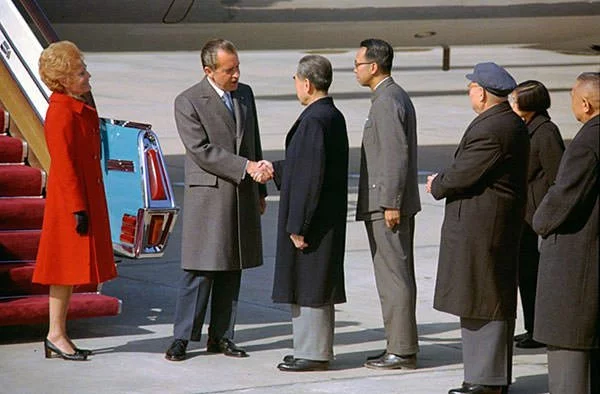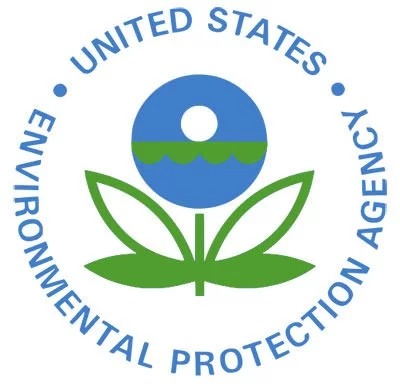Richard Milhous Nixon (1913 – 1994) served as the 37th President of the United States from 1969 to 1974. During the Second World War, Nixon served in the U.S Naval Reserve and, prior to becoming president, he served as a Senator from California and then as Vice President during the Presidency of Dwight D. Eisenhower from 1953 to 1961. As President, in domestic affairs, Nixon initiated the drive for achieving self sufficiency in energy in U.S.; and enforced several groundbreaking environmental measures. In foreign affairs, he improved American relations with China and the Soviet Union; and ended the involvement of the United States in the Vietnam War. Despite these achievements, Richard Nixon is primarily famous for his involvement in the Watergate Scandal. Here are the 10 major accomplishments of Richard Nixon and a summary of his involvement in the Watergate Scandal.
#1 HE SERVED IN THE US NAVAL RESERVE DURING WW2
During World War II, Richard Nixon applied to join the United States Navy. On June 15, 1942, he was appointed a lieutenant junior grade in the U.S Naval Reserve. In July 1943, he was appointed to Marine Aircraft Group 25 and the South Pacific Combat Air Transport Command (SCAT). Here, he supported the logistics of operation in the South Pacific Theatre of WW2. On October 1, 1943, Nixon was promoted to lieutenant. His unit prepared manifests and flight plans as well as supervised the loading and unloading of transport aircraft. He received a Navy and Marine Corps Commendation Medal for “meritorious and efficient performance of duty as Officer in Charge of the South Pacific Combat Air Transport Command”. When he returned to the United States, he worked at the Bureau of Aeronautics office in Philadelphia from January 1945. In this role, he helped negotiate the termination of war contracts. For this, he received his second letter of commendation for “meritorious service, tireless effort, and devotion to duty”. On October 3, 1945, Nixon was promoted to lieutenant commander; and on June 1, 1953, he was promoted to commander. He retired from the U.S. Naval Reserve on June 6, 1966.

#2 HE WAS THE SECOND YOUNGEST VICE PRESIDENT IN AMERICAN HISTORY
In California’s 12th congressional district, the Republicans had been unable to defeat Democrat Jerry Voorhis, who had been serving since 1937. Richard Nixon was chosen as the Republican candidate against Voorhis and he won the election receiving 65,586 votes to Voorhis’s 49,994. Nixon served as a Congressman from California’s 12th district from January 3, 1947 to November 30, 1950. He then served as a Senator from California from December 1, 1950 to January 1, 1953. In the 1952 United States presidential election, Nixon was the running mate of Republican Dwight D. Eisenhower, who won a landslide victory. Richard Nixon served as the 36th Vice President of the United States under President Eisenhower from January 20, 1953 to January 20, 1961. He was the second-youngest vice president in American history at age 40. Nixon took on major responsibilities as vice-president. In 1953, he went on an important tour to meet Asian leaders and was the first American foreign state official to visit Japan since the end of World War II. He was also instrumental in pushing through the Civil Rights Act of 1957.

#3 HE SERVED AS THE 37TH PRESIDENT OF THE UNITED STATES
Nixon ran for presidency in the 1960 presidential election but lost to Democrat John F. Kennedy. He then lost the 1962 election for the post of Governor of California and it was thought that his political career was over. However, he was elected as the Republican candidate for the 1968 United States presidential election. The election was a three way race between Nixon, Democratic Vice President Hubert Humphrey and American Independent Party candidate, former Alabama Governor, George Wallace. Richard Nixon won the election with 301 electoral votes to 191 for Humphrey and 46 for Wallace. He also received 43.4% popular vote as compared to 42.7% for Humphrey and 13.5% for Wallace. In the 1972 presidential elections, Nixon was re-elected with a landslide victory over Democratic Senator George McGovern of South Dakota. Nixon won 520 electoral votes and 60.7% of the popular vote. He was the first Republican to sweep the South. Moreover, he received almost 18 million more votes than McGovern. He still holds the record for the widest popular vote margin in any United States presidential election. Richard Nixon served as the 37th President of the United States from January 20, 1969 till his resignation on August 9, 1974.

#4 HE INITIATED AN ERA OF IMPROVED RELATIONS WITH CHINA
In 1949, the communists took over mainland China and the nationalists fled to the island of Taiwan. The United States recognized Taiwan, or the Republic of China, as the sole government of China neglecting the People’s Republic of China (PRC). On becoming President, Richard Nixon sought to establish better ties with the PRC. After a series of diplomatic overtures, Nixon visited the People’s Republic of China in 1972 becoming the first president from the United States to do so. The week long visit, which lasted from February 21 to 28, is considered a vital diplomatic and strategic success. Nixon’s visit ended 25 years of no diplomatic ties or communication between the two countries. It was a massive event in terms of international politics, representing a key step in normalizing the relationship between China and the United States; and ushering in a new era of Sino-American relations. This visit also allowed the United States greater leverage with the Soviet Union, who now feared a Sino-American alliance against them.

#5 HE HELPED REDUCE TENSIONS BETWEEN U.S. AND THE SOVIET UNION
To ease rising tensions between the United States and the Soviet Union, Nixon engaged in intense negotiations with Leonid Brezhnev, the General Secretary of the Communist Party. These negotiations resulted in increased trade between the two nations. Moreover, the Strategic Arms Limitation Talks Agreement (SALT I) and the Anti-Ballistic Missile Treaty (ABMT) were signed by the two countries. Signed on May 26, 1972, SALT I froze the number of strategic ballistic missile launchers at existing levels. New submarine-launched ballistic missile (SLBM) launchers could only be added once the same number of older intercontinental ballistic missile (ICBM) had been dismantled. Signed on May 26, 1972, the ABMT limited the anti-ballistic missile (ABM) systems of the two nations. Each nation was limited to two ABM complexes, each of which was to be limited to 100 anti-ballistic missiles. All these measure helped to curtail the threat of nuclear war between the two superpowers of the world. Moreover, better American relations with China and the Soviet Union led to the two nations reducing their diplomatic support for North Vietnam and asking it to negotiate an end to the conflict.

#6 HE ENDED U.S. INVOLVEMENT IN THE VIETNAM WAR
During the presidential elections, Nixon had promised that the “new leadership will end the war (Vietnam War) and win the peace in the Pacific”. When he assumed office, around 300 American soldiers were dying each week in Vietnam. Moreover, there were strong protests against the war in the United States. Nixon handled the situation by what became know as “Vietnamization”. It involved replacing American troops with Vietnamese troops. He then began withdrawing American troops from the nation. On May 8, 1972, President Nixon made a major concession to North Vietnam by announcing that the U.S. would accept a cease-fire in place as a precondition for withdrawing its troops from South Vietnam. This led to progress in talks in the following months. Finally, on January 27, 1973, the Paris Peace Accords were signed between North Vietnam, South Vietnam, the United States and Provisional Revolutionary Government (PRG), that represented indigenous South Vietnamese revolutionaries. The Paris Peace treaty led to the United States withdrawing all its troops from the Vietnam War. However, the provisions of the treaty were immediately broken without any response from the U.S. North Vietnam conquered South Vietnam in 1975. Thus the Vietnam War may be considered as a major failure for the United States.

#7 HE INITIATED THE DRIVE FOR ACHIEVING SELF SUFFICIENCY IN ENERGY
On October 6, 1973, an Arab coalition led by Egypt and Syria attacked Israel beginning the Yom Kippur War. With the support of the United States, Israel won the war. However, due to this, the members of the Organization of Arab Petroleum Exporting Countries instituted an embargo and stopped exporting oil to the US. Nixon responded to this by introducing several measures including oil rationing and reducing the speed limit on highways. More importantly, Nixon put in place his “Project Independence”, a huge project that aimed to see the country achieve self-sufficiency in terms of energy within a seven-year period, by 1980. This was to be achieved through a country commitment to the conservation of energy and the development of different sources of energy. Federal investments in energy R&D “more than doubled in real terms in the short interval between 1973 to 1976”. Though his dream was not realized, Nixon’s focus on energy had long term benefits for the United States in terms of conservation measures, expanded research and increased domestic production of all forms of energy.
#8 HE ENFORCED SEVERAL GROUNDBREAKING ENVIRONMENTAL MEASURES
On January 1, 1970, President Nixon signed into law the National Environmental Policy Act (NEPA). NEPA outlined for the first time a formal declaration of national environmental policies and goals; it established provisions for federal agencies to enforce such policies and goals; and created the President’s Council on Environmental Quality (CEQ). Moreover, NEPA made it mandatory to prepare a detailed statement of environmental impacts for major federal actions which could affect the environment. NEPA was hugely influential and, to date, more than 100 nations around the world have enacted national environmental policies modeled after NEPA. Apart from NEPA, the Clean Air Act of 1970 (1970 CAA) and the Marine Mammal Protection Act (MMPA) of 1972 were passed during the Presidency of Nixon. The 1970 CAA is regarded as the most significant air pollution control bill in American history. It enabled Environmental Protection Agency (EPA) to enforce regulations to protect people from hazardous air pollution. The MMPA was the first Act to protect marine mammals. Among other things, it allowed government to enforce measures to reduce marine mammal casualties; created guidelines for public display of marine mammals like dolphins; and regulated import and export of marine mammals.

#9 HE ESTABLISHED THE ENVIRONMENTAL PROTECTION AGENCY
On July 9, 1970, Richard Nixon proposed an executive reorganization which would consolidate environmental programs from other agencies into a single entity. The Environmental Protection Agency (EPA) began operation on December 2, 1970, after Nixon signed an executive order. The EPA became the central authority which oversaw the protection of the environment. It was given the responsibility of maintaining and enforcing national standards under a variety of environmental laws. Its enforcement powers include fines, sanctions and other measures. The EPA also conducts environmental assessment, research and education. Since its establishment, it has grown into a major body and, as of 2018, it had 14,172 full-time employees. On December 28, 1973, President Nixon signed into law the Endangered Species Act to protect critically imperiled species from extinction as a “consequence of economic growth and development untempered by adequate concern and conservation”. In 1974, Nixon also proposed the Safe Drinking Water Act. However, it was signed into law by his successor Gerald Ford. The law requires actions to protect drinking water and its sources, including reservoirs, springs and groundwater wells.

#10 HE MADE SIGNIFICANT CONTRIBUTION TO FIGHT DRUGS AND CANCER
On December 29, 1970, President Nixon established the Occupational Safety and Health Administration (OSHA). The aim of OSHA is to “assure safe and healthy working conditions for working men and women by setting and enforcing standards and by providing training, outreach, education and assistance”. Another initiative taken by Nixon was his “war on drugs”. Nixon called for “prevention of new addicts, and the rehabilitation of those who are addicted”. The Comprehensive Drug Abuse Prevention and Control Act of 1970 was signed into law by Nixon on October 27. It directed the pharmaceutical industry to maintain physical security and strict record keeping for certain types of drugs. President Nixon also initiated the “war on cancer”. On December 23, 1971, he signed into law the National Cancer Act, which aimed “to amend the Public Health Service Act so as to strengthen the National Cancer Institute in order to more effectively carry out the national effort against cancer”. This Act is considered as the beginning of the American effort to eradicate cancer as a major cause of death.

THE WATERGATE SCANDAL
Despite his achievements, the reputation of Richard Nixon will always be tarnished by the Watergate Scandal. On June 17, 1972, five thieves were arrested for breaking in the Democratic National Committee (DNC) headquarters. These offices were situated in the Watergate Complex of Washington, DC, hence the name Watergate Scandal. When the FBI investigated the burglary it was found that it was related to the Committee for the Re-Election of the President (CRP), the official organization of Nixon’s campaign for the presidential election. As the investigation went on, multiple abuses of power by members of the Nixon administration came to light. These included bugging the offices of political opponents; and using agencies like the FBI, the CIA and the IRS as political weapons. Moreover, Nixon also attempted to cover up the scandal and used federal officials to deflect the investigation. Facing certain impeachment, Richard Nixon resigned the presidency on August 9, 1974. On September 8, 1974, his successor, Gerald Ford, pardoned him.


I wish more schools would provide an in-depth analysis of people like Nixon so children can really learn people are complicated and shouldn’t be dropped in a single ‘good’ or ‘bad’ box.
Nope. Nixon has been boxed. He will forever exist within a single scandal.